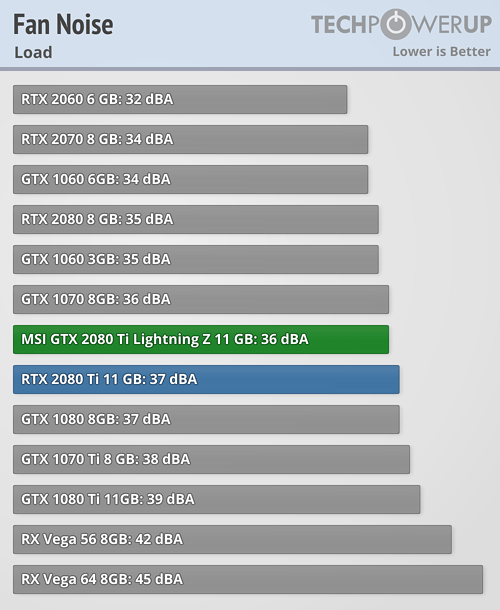 50
50
MSI GeForce RTX 2080 Ti Lightning Z 11 GB Review
Overclocking »Temperatures

| GPU Temperature Comparison | |||
|---|---|---|---|
| Idle | Load | Gaming Noise | |
| ASUS RTX 2080 Ti STRIX | 37°C | 65°C | 36 dBA |
| ASUS RTX 2080 Ti STRIX (quiet BIOS) | 46°C | 75°C | 31 dBA |
| EVGA RTX 2080 Ti FTW3 Ultra | 42°C | 64°C | 38 dBA |
| EVGA RTX 2080 Ti FTW3 Ultra (OC BIOS) | 42°C | 62°C | 40 dBA |
| EVGA RTX 2080 Ti XC Ultra | 50°C | 71°C | 35 dBA |
| MSI RTX 2080 Ti Duke | 53°C | 71°C | 34 dBA |
| MSI RTX 2080 Ti Gaming X Trio | 53°C | 74°C | 36 dBA |
| MSI RTX 2080 Ti Lightning Z | 40°C | 74°C | 36 dBA |
| NVIDIA RTX 2080 Ti Founders Edition | 42°C | 77°C | 37 dBA |
| Zotac RTX 2080 Ti Amp | 37°C | 65°C | 39 dBA |
Fan Noise
The MSI RTX 2080 Ti Lightning lacks the idle-fan-off feature we all love so much. However, with 26 dBA in idle, it is extremely quiet in that state and won't be audible when used in a case with any other actively cooled components. Still, given the massive heatsink, I do wonder why MSI didn't include fan-stop.
Gaming noise levels are slightly improved over the Founders Edition, but not by much—if you are looking for a low-noise option, other cards do better here. Given the card is targeted at overclockers, who don't worry much about fan noise, this shouldn't be a problem.


Mar 10th, 2025 06:32 EDT
change timezone
Latest GPU Drivers
New Forum Posts
- RX 9000 series GPU Owners Club (35)
- I'm looking for a good tool to make the 3D scanning of my mini-pc using the photogrammetry and my Kinect 2. (38)
- What is a good real price for the RTX 5090? (18)
- RTX 5090 ridiculous price! (194)
- RX 9070 availability (122)
- BIOS request 10DE:25A2 1043:13DC (8)
- Nvidia's GPU market share hits 90% in Q4 2024 (gets closer to full monopoly) (763)
- As we live the age of game remakes, which game you would like to see to have a remake? (358)
- Help me find bios (1)
- The TPU Darkroom - Digital SLR and Photography Club (4070)
Popular Reviews
- Sapphire Radeon RX 9070 XT Nitro+ Review - Beating NVIDIA
- XFX Radeon RX 9070 XT Mercury OC Magnetic Air Review
- ASUS Radeon RX 9070 TUF OC Review
- MSI MAG B850 Tomahawk Max Wi-Fi Review
- NVIDIA GeForce RTX 5080 Founders Edition Review
- NVIDIA GeForce RTX 5070 Founders Edition Review
- Corsair Vengeance RGB CUDIMM DDR5-8800 48 GB CL42 Review
- AMD Ryzen 7 9800X3D Review - The Best Gaming Processor
- ASUS GeForce RTX 5070 Ti TUF OC Review
- MSI GeForce RTX 5070 Ti Gaming Trio OC+ Review
Controversial News Posts
- NVIDIA GeForce RTX 50 Cards Spotted with Missing ROPs, NVIDIA Confirms the Issue, Multiple Vendors Affected (513)
- AMD Plans Aggressive Price Competition with Radeon RX 9000 Series (277)
- AMD Radeon RX 9070 and 9070 XT Listed On Amazon - One Buyer Snags a Unit (261)
- AMD RDNA 4 and Radeon RX 9070 Series Unveiled: $549 & $599 (260)
- AMD Mentions Sub-$700 Pricing for Radeon RX 9070 GPU Series, Looks Like NV Minus $50 Again (248)
- NVIDIA Investigates GeForce RTX 50 Series "Blackwell" Black Screen and BSOD Issues (244)
- AMD Radeon RX 9070 and 9070 XT Official Performance Metrics Leaked, +42% 4K Performance Over Radeon RX 7900 GRE (195)
- AMD Radeon RX 9070-series Pricing Leaks Courtesy of MicroCenter (158)
